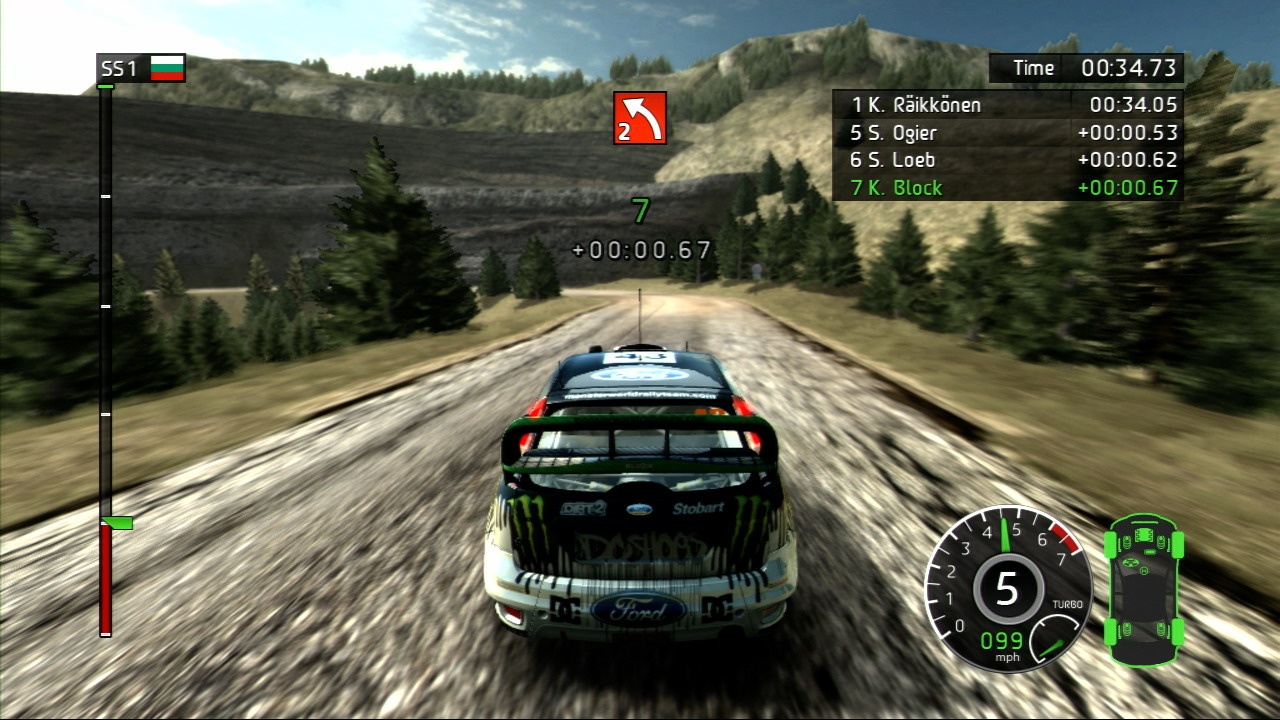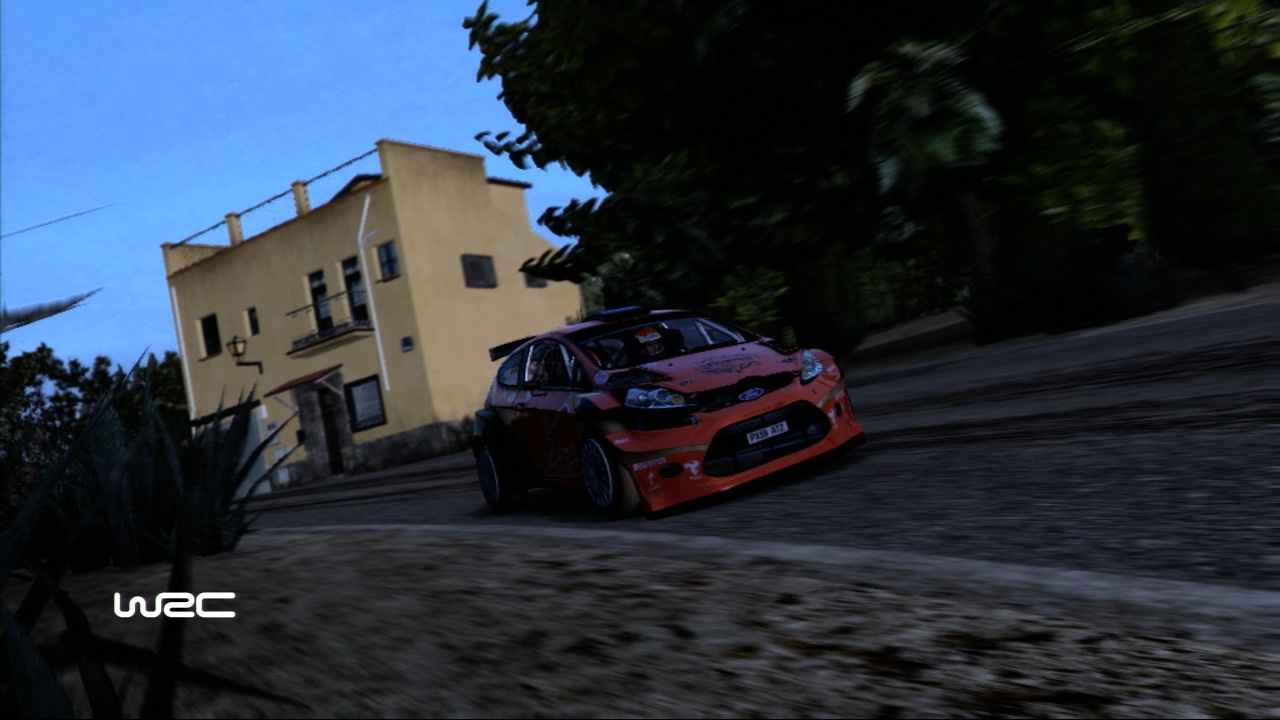In WRC: FIA World Rally Championship, you assume the role of a young off-road racer looking to work your way up the ranks and join the world's elite rally drivers. Facing off against guys like Ken Block and seven-time champion Sebastien Loeb might sound like a difficult task, but WRC's variety of difficulty levels and lengthy career mode help to ease you into competitive rallying as you progress through the game's three support classes. WRC is more realistic than some other recent rally games, featuring a deep and rewarding handling model. However, it also manages to remain accessible while retaining the excitement that simulation fans expect. Unfortunately, the game suffers badly from terrible visuals, long loading times, and poorly implemented steering wheel support that doesn't do justice to the realistic handling.

WRC features responsive controls and a robust handling model. If you slog through the early stages in the slow and understeering front-wheel-drive cars, you're rewarded with the powerful and twitchy production rally class and WRC cars that are unlocked later. There are also a huge variety of stages on offer, based on the official locations of the 2010 Championship. Surfaces include tarmac, gravel, mud, sand, and ice. There is a real difference in car handling among road surfaces, with the hardest stages combining different types, making car setup and quick reactions important if you want to be successful. The effects of the different surfaces are impressively conveyed through the sound design, with clear sounds for different tyres running on the variety of surfaces available. Unfortunately, WRC does not include a flashback/rewind feature similar to DiRT 2 and GRID, which makes a perfect performance all the more difficult. Because of this omission and the often-long point-to-point stages, the game can be incredibly frustrating at times. Realism comes at a cost in WRC; one high-speed mistake right at the end of a course can result in the car being wrecked. Rally purists will love this hardcore aspect of the game, but it's a turnoff for casual off-road fans.
Though the skill level can be intimidating at first, the game is accessible to newcomers. WRC includes simple explanations for each part of the car setup and even offers different default setups tailored for each stage. A traditional selection of driving assists, such as braking assist and steering help, is in place to help newcomers settle in quickly. Even AI ability is selected on a slider in the options screen, making it easy to fine-tune the game's difficulty level to your own taste. You can also brush up on your technique in the Rally Academy tutorial mode. This involves playing short sections of a variety of stages from the game but with a suggested racing line to better inform your approach to corners, braking, and acceleration. Each Rally Academy challenge uses a different car and often a different surface. This mixture of courses teaches you the basics of how to approach different tricky road-surface changes, as well as how to approach different severities of corners, right up to hand-brake turns around tight hairpins. The whole mode takes about 45 minutes to complete, but by doing so, you will become much more comfortable with the basics of WRC's handling physics. Unfortunately, there is no such training on offer for players who wish to use a steering wheel. The wheel controls in WRC are incredibly sensitive and the game doesn't offer the opportunity to tweak sensitivity or dead zones on the fly. The default levels of force feedback are also far too fierce.
At the start of the Road to WRC career mode, you are asked to name your own team and driver. From here, you enter into tiered events, which start with slower cars and progress to quicker vehicles. Completing a percentage of the events on each tier will unlock the next one. It's a tried-and-tested career path that has become a staple of the driving genre, and it works as well in WRC as in any other racing game. After your first handful of races in the slower front-wheel-drive cars, you unlock new vehicles, which can be bought with credits earned by achieving your team objectives. Again, this is not a wholly original idea, but in WRC, it is backed up by a fairly substantial team editor. You can purchase a variety of different patterns to place on your cars and also choose the colours, selecting a base, as well as primary and secondary colours for the pattern. Successful racing will give you access to new sponsors who offer extra cash and allow you to place their logos on your cars. Unfortunately, while this is a great idea to help you craft an identity for your team, the sponsor logos can only be placed on two predetermined parts of the car and none of the companies are real-world organisations. This really breaks the sense of immersion in the career mode--brands such as "The Daily Carrot Village" really don't sit well in the high-octane world of rallying. The customisation is also devalued by the fact that once you reach the WRC itself, you are forced to join one of the real 2010 teams rather than compete under your own banner.
Outside of the main Road to WRC mode, you can also take part in time trials, individual stages, a full rally event, or a full championship in the class and car of your choice. This helps to give the game some extra depth on top of the already substantial career mode. Although there is no split-screen multiplayer, there is a hot-seat mode where players can take turns, competing in any of the single-player race types. It's an interesting addition, but a full championship in this mode requires a huge time investment. If you take the game online, you'll find a comprehensive choice of events, each for 16 players. Single stages, rallies and championships are all available, and each mode works well. Everyone races on the stage together, competing to be the fastest to the finish. However, there is no contact, and you can only see ghosts of the other players. Oddly, the ghosts appear to change colour from green and purple to transparent, and they can be hugely distracting when you're trying to concentrate on a good run. Thankfully, an option has been included to turn them off so that you can choose to focus on the road ahead instead. Completing races rewards you with experience points, allowing you to level up in each car class. Unfortunately, there are no tangible rewards tied to the XP system, making its inclusion seem a little arbitrary.

The cars in WRC are very detailed, featuring a variety of destructible parts and realistic reflections. Bumpers and wings can be damaged, causing them to hang loosely or to be ripped off entirely. In the cockpit camera, if the hood takes enough hits, it will bounce up over jumps obscuring your view, and the windscreen will crack if you hit obstacles. The cars even collect dirt from the tracks, with some surfaces, such as snow and mud, completely covering your vehicle by the end of an event. That said, the damage modeling in the game is wonky--sometimes it takes only the tiniest of bumps to destroy a part, such as the gearbox or suspension, but at other times, cars are be able to hit trees at 90mph and come away without so much as a scratch on the bodywork. The interiors are also not very well modeled. They mostly feature a generic low-resolution dashboard design, with very few differences among the cars. Though the game does offer two different cockpit cameras (one is closer to the windscreen than the other), it doesn't offer anything in the way of dirt buildup or water splashes off the windscreen, which lessens the sense of immersion.
These initial visual issues are compounded by the bland environments and noticeable texture pop-in. The vast majority of the circuits are covered with murky textures, grey skies, and brown roads. Some of this obviously has to do with the nature of the sport itself, but the game is characterised by a dreary look overall. Driving the circuits is also a very lonely experience. There are no staggered starts as in the real sport, meaning there are no other drivers on the track, so you race entirely on your own. This means that you cannot catch up to any other drivers who started the stage before you, and there are never any crashed drivers at the side of the road. The game has a tendency to feel like a long series of time trials, rather than a full rally experience.
WRC is an enjoyable racing game. It certainly isn't a true simulation, but it has a much more realistic feel than some of its recently released competitors. The handling is satisfying and encourages high concentration and driving control, rewarding hardcore rally fans with responsive controls that feel just right when you execute maneuvers like the Scandinavian flick. Unfortunately, the robust physics are often let down by the game's woeful presentation, poor steering-wheel calibration, and horrendous loading times. That said, there are very few traditional rally games on the market for the current generation of consoles, and WRC provides all the thrills and driving precision that fans of the real championship have been craving. If you look beyond the troublesome graphics and minor gameplay issues, you will find a rewarding game that makes for a realistic rally experience.